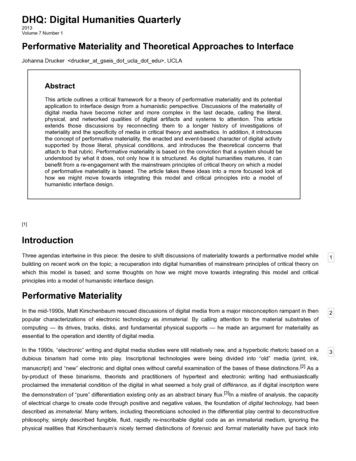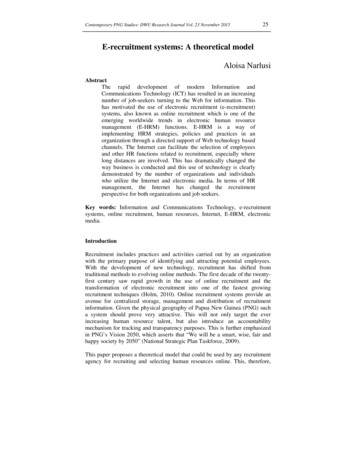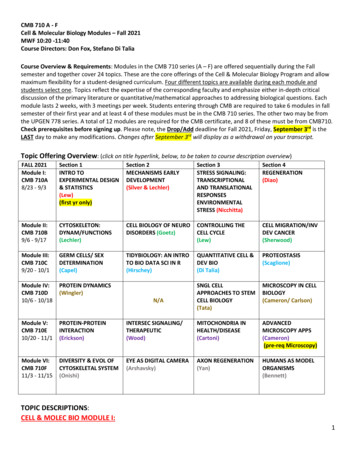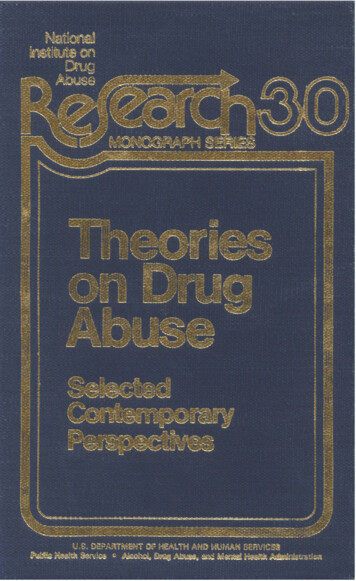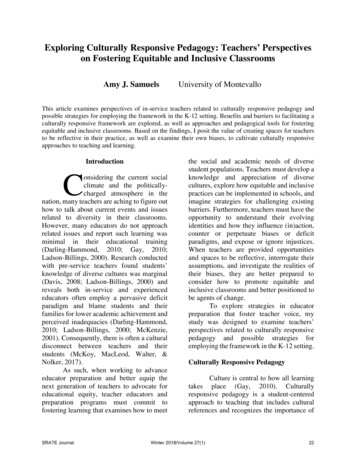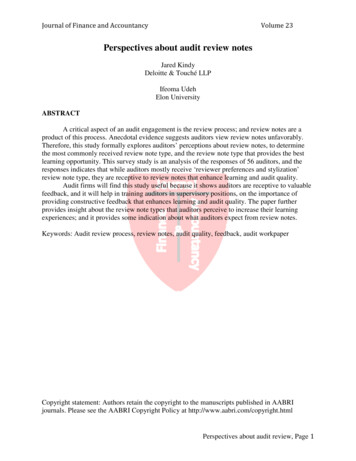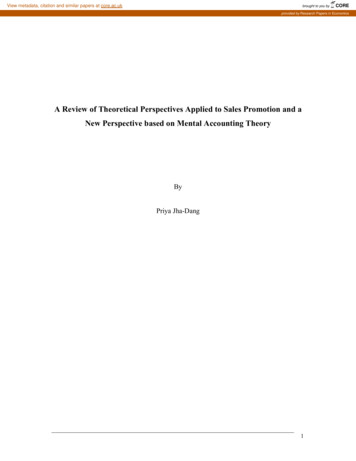
Transcription
View metadata, citation and similar papers at core.ac.ukbrought to you byCOREprovided by Research Papers in EconomicsA Review of Theoretical Perspectives Applied to Sales Promotion and aNew Perspective based on Mental Accounting TheoryByPriya Jha-Dang1
AbstractThe paper reviews theoretical perspective applied to the study of consumer response topromotions. These include adaptation level theory, assimilation contrast theory,attribution theory, prospect theory, transaction utility theory, the elaboration likelihoodmodel and the attitude model. It finds that these theoretical approaches have had a singleproduct focus in evaluating consumer response to promotions. It suggests an alternativetheoretical perspective to examine consumer response to promotion from a multi productperspective. This perspective is based on mental accounting theory, a behaviorally basedmodel of choice. It is used to examine the psychological processes involved in creating apositive cross product impact of a promotion (i.e. increase in sale of regular pricedproducts during a promotion).2
A Review of Theoretical Perspectives Applied to Sales Promotion and aNew Perspective based on Mental Accounting TheoryThe substantial body of literature on promotions is composed of three broad streams ofresearch. The first stream of research is concerned with the empirical estimation of theeffects of price promotion on aggregate market outcomes such as sales, market share andbrand switching (Appendix 1). This stream of research is largely descriptive and seeks tomeasure the height of the promotional spike in sales (Gupta, 1988), the promotional priceelasticity (Guadgani and Little,1983; Kamakura and Russell, 1989), and the postpromotion average repeat purchase rate (Shoemaker & Shoaf, 1977; Dodson et.al, 1978).The second stream of research seeks to identify the promotion sensitive consumer interms of demographics, psychographics and purchase behavior (Appendix 1). This streamof research characterizes the promotion sensitive consumer in terms of variables such asincome, household size, age and gender. The third stream of research examines thepsychological impact of promotions on consumer behavior and decision-making. It usespsychological theories and models to explain why consumers respond to promotions.In the current paper, the theoretical approaches used to study consumers’ psychologicalresponse to promotions are reviewed. The review indicates that the theoretical approacheshave had a single product focus in evaluating consumer response to promotions. Thepaper proposes an alternative theoretical perspective to evaluate consumer response topromotions from a multi product perspective. This perspective is used to study thepsychological processes leading to a positive cross product impact of a promotion (i.e.increase in sale of regular priced products during a promotion).3
A Review of Theory and Research Related to PromotionsMost of the theoretical research on promotions has concentrated on aspects of price andits impact on consumer judgments. This is probably due to the fact that the bulk of theresearch has focused on price promotions. Studies have examined the impact of pricepromotions on consumers’ internal reference price (Lattin and Bucklin, 1989; Kalwaniand Yim, 1992) and the impact of comparative price advertising1 on consumer perceptionof savings obtained from a price promotion (Berkowitz and Walton, 1980; Urbany,Bearden and Weilbaker, 1988; Bearden, Lictenstein and Teel, 1984). The theoreticalapproaches, which have been used to study the price-related aspects of a promotion,include adaptation level theory and assimilation contrast theory. Apart from these, othertheoretical approaches used to study consumer response to price promotions includeattribution theory, transaction utility theory, the attitude model and the elaborationlikelihood model. Each of these theoretical approaches is discussed in detail below. Adaptation Level TheoryThis theory proposes that consumers carry with them an adaptation level price or‘internal reference price’ for a given product (Monroe, 1979). The internal reference priceis represents the price a consumer expects to pay for a product and is formed on the basisof past prices paid/observed either for the same product or similar products. The internalreference price is a standard against which market prices are compared and judged ashigh, low or medium. The existence of internal reference prices has been confirmed inseveral laboratory studies (Gurumurthy and Winer, 1995).Researchers have proposed that consumers respond to a price promotion based on thecomparison between the internal reference price and the promotional price (Lattin andBucklin, 1989; Kalwani and Yim, 1992). Frequent price promotions can lead consumers1A comparative price ad presents the higher regular price of a product along with the lower promotionalprice in an attempt to document the savings associated with the lower promotional price.4
to lower the reference price for the promoted product. Consumers with lowered referenceprices will be unwilling to pay the full price of a product once the promotion is over.Winer (1986) investigated the nature of reference price effects on brand choice through alinear probability model whereby the probability of purchase for a brand was a functionof the observed price and the difference between the observed price and reference price.He found that the model predicted probability of purchase better than standard demandmodels that incorporated only observed brand prices. In another laboratory experiment,Kalwani, Yim, Rinne and Sugita (1990) demonstrated that customer brand choice andjudgments were mediated through customers’ price expectations for a brand. Theyshowed that consumers’ price expectations were formed based on past prices of thebrand, customer characteristics and situational factors. The authors found that a brandchoice model that included consumers’ price expectations predicted choice better than amodel which included only observed prices. Mayhew and Winer (1992) examined therelative impact of internal reference price (prices stored in memory) and externalreference price (prices provided by stimuli in the purchase environment) on consumerbrand choice. They estimated choice models with variables representing the two types ofreference prices and found that both types of variables had a significant impact onpurchase probabilities.In a study on the reference effects of price and promotion on consumer choice behavior,Lattin and Bucklin (1989) found that consumers form reference points for both price andpromotional activity. These reference points are based on consumer’s previous exposureto prices and promotions and affect subsequent patterns of brand choice. The authorsstated that too much price discounting would blur the distinction between the promotionalprice and the regular price of the product thus lowering consumer reference price for theproduct. Kalwani and Yim (1992) investigated the impact of a brand’s price promotionfrequency and depth of price discounts on a brand’s expected price and brand choice.They demonstrated that both price promotion frequency and depth of price discounts hada significant impact on price expectations. Results of an experiment showed that thelarger the amount of a price reduction on a product, the lower the price people expected5
to pay for it on the next purchase occasion. Similar to Lattin and Bucklin, (1989) theauthors found that consumers form both promotion and price expectations. The authorsstated that, for a frequently promoted brand, consumers may form price and promotionexpectations and will purchase the brand only when it is available at a lower promotionalprice.An implied assumption of the price perception theory studies is that consumers notice theprices of all brands when they purchase a product. A number of these studies (Kalwaniand Yim, 1992; Mayhew and Winer, 1992; Kalwani, Yim, Rinne and Sugita, 1990) havebeen carried out in a laboratory setting where consumers have been presented with aseries of prices and responses have been elicited from them. In other studies, the internalreference price has not been directly measured but represented through a proxy measureof linearly lagged or exponentially smoothed past prices (Gurumurthy and Winer, 1995).Research done in real-life settings has shown that consumers have a hazy notion of pricesof frequently purchased products. Studies in actual shopping contexts have found thatshoppers cannot correctly name the price of an item which they have just placed in theshopping cart (Dickson and Sawyer, 1990) and are unable to recall levels of pricediscounts just after having bought a product (Davis, Inman and Mcalister, 1992).The internal reference price concept is an extensively researched concept in pricing andpromotional literature (Gurumurthy and Winer, 1995). Based on the fact that pricepromotions reduce consumer reference price for a product, this theoretical approachpredicts a negative long-term impact of promotions. However, several studies done at theaggregate market level have found that price promotions have no long-term negativeeffects. It is important to note that the internal reference price concept is useful inexplaining consumer reaction to promotions that lower the price of the product and henceimpact reference price. However, non price promotions do not lower the price of aproduct and do not impact internal reference price (Diamond and Campbell, 1992). Assuch, this theoretical approach is not useful in explaining consumer reaction to a varietyof non price promotions such as extra product offers and free gift offers.6
Assimilation Contrast TheoryAssimilation contrast theory examines how external reference prices influenceconsumers’ internal reference price and subsequent promotion evaluations. An externalreference price may be introduced through a price advertisement or in-storecommunication that features both the lower promotional price and the higher regularprice and, thus, documents the savings associated with the lower promotional price. Asper assimilation contrast theory, an external reference price that is moderately higher thana consumer’s internal reference price, is perceived as plausible and assimilated. Thisassimilation effect results in a shift of the internal reference price toward the higherexternal reference price and a corresponding increase in favorability of promotionevaluations. However, if the external reference price vastly exceeds the highest expectedregular price, it is likely to be perceived as unbelieveable and hence contrasted withinternal price standards. Studies based on adaptation level theory have shown thatpromotional advertisements that include the external reference price produce largerperception of savings than advertisements that include only the lower promotional price(Blair and Landon, 1979; Berkowitz and Walton, 1980; Urbany, Bearden and Weilbaker,1988; Bearden, Lichtenstein and Teel, 1984). Researchers have found that although veryhigh external reference prices are somewhat discounted, they still manage to raiseconsumer perceptions about the value of a price promotion (Urbany, Bearden andWeilbaker, 1988).Blair and Landon (1979) found that promotional advertisements, which included thehigher regular price along with the lower promotional price, produced larger perceptionsof savings than advertisements that included only the lower promotional price. Theauthors found that subjects were skeptical of high external reference price claims andtypically believed that these price claims were about 25% higher than the true prices. Thegreater was the percentage difference between the promotional price and the advertisedregular price, the less believable was the external reference price.7
Berkowitz and Walton (1980) conducted a study to assess the influence of advertisedreference prices and store image on consumer perception of savings and willingness tobuy. Results of their study showed that the presence of advertised reference pricesgenerated higher perception of savings, perceived worth and willingness to buy. Resultsof the study also showed a store quality interaction such that higher discount levelsproduced relatively less positive responses with the discount store.Della Bitta, Monroe and McGinnis (1981) investigated the effect of presenting differentlevels of regular price and promotional price on consumer evaluations. They found thathigher price discounts provided greater perceptions of value, less intent to search andgreater interest in product. Significant differences in evaluation were found between the10% and 40% discount levels and between the 20% and 50% discounts levels.Advertisements, which presented comparative price information received betterevaluations on willingness to purchase. The information format that received the highestratings was the one that presented the regular price, the lower promotional price and thepercentage off. Advertisements that presented the regular price and the dollar amount offwere rated significantly higher advertisements that presented regular price and percentoff.Bearden, Lichtenstein and Teel (1984) examined the effect of varying brand labels (e.g.national, private, generic), the presence or absence of coupon and the inclusion ofexternal reference prices on consumer reactions to retail newspaper advertisements.Results showed that more positive attitudes and greater intention to purchase was presentfor national brands as compared to private label and generic brands irrespective of theprice presentation format. No difference was found between advertisements with/withoutcoupons with respect to consumer price perceptions, attitudes towards purchase andintentions to purchase. Inclusion of reference prices led to more positive consumer priceperceptions, attitudes towards purchase and intention to purchase.Urbany, Bearden and Weilbaker (1988) investigated the effect of advertised referenceprices on estimates of average market prices, perceived offer value and perceived benefits8
of search. Results indicated that advertised reference prices positively impacted perceivedoffer value and the size of the effect increased as the advertised discount increased.Findings suggested that even exaggerated reference prices influenced consumer beliefsabout the advertised products and market prices. It appeared that exaggerated referenceprices were somewhat discounted but not totally dismissed. The authors found that theperceived benefits of search were enhanced through higher estimates of average marketprices and regular market prices.Gupta and Cooper (1992) found that consumers’ perceptions of price discounts weretypically lesser than the advertised price discounts i.e. consumers ‘discounted pricediscounts.’ The ‘discounting of price discounts’ was moderated by the discount levelsuch that it increased with increases in the advertised discount. The authors found thatconsumers did not change their intentions to buy unless the promotional discount wasabove a threshold level of 15% of purchase price. They also found a discount saturationpoint located at 40% of the purchase price, above which the effect of discounts onconsumer’s purchase intention was minimal. The results of the study suggested a Sshaped response of consumer response to price discounts.Grewal and Marmorstein (1996) found that consumer’s processing of price informationdepended on the size of the discount provided. It was seen that consumers increased theirprocessing of information as the discount size increased from the low to moderate. Thedepth of consumers’ processing declined as the size of the price reduction increasedfurther. The authors explained their findings by stating that for low discount sizes,consumers were unlikely to expend the cognitive effort to process additional informationas the price promotion was deemed to be of little value. Similarly when the discount sizewas judged to be acceptably high but plausible, there was again little uncertainty aboutthe perceived value of the offer and consumers were unlikely to be motivated to processadditional information in detail. Consumers were expected to process additionalinformation related to a price promotion most elaborately when the discount size was inthe moderate range because here the perceived value of the offer was uncertain.9
Studies based on assimilation contrast theory have indicated the importance of externalreference price in influencing consumer price judgments. Although very high externalreference prices are seen to be discounted, the presence of such prices produces largerperception of consumer savings. Although this theoretical approach has been used only inthe context of price promotions, it can be extended to the evaluation of non pricepromotions. For example, in the context of an extra product promotion, it would be usefulto evaluate the threshold and saturation quantities of free product that produce consumerperception of savings. A similar evaluation could be done for a premium promotion. Attribution TheoryAttribution theory describes how consumers explain the causes of events (Mizerski,Golden and Kernan, 1979) Different types of attribution can be distinguished based onthe object about which the attribution is being made. Attributions made about self (the‘why-did-I-buy’ question) come under self perception theory while attributions madeabout an object/ brand (the ‘why-is-brand-X-on-promotion’) come under objectperception theory. Each is analyzed in the context of promotions.Self perception theory: Researchers who have applied self perception theory to pricepromotions have stated that a purchase in the presence of a strong promotion is expectedto lead the consumer to attribute purchase to an external cause (i.e. the promotion) ratherthan an internal cause (i.e. liking for the product). This will lead to discounting of afavorable brand attitude and repeat purchase probability will diminish. Basically, selfperception theory suggests a negative long term effect of price promotions on consumerattitudes and behavior.Dodson, Tybout and Sternthal (1978) examined different types of price promotions media distributed coupons, cents off marked packages and on/in-package coupons - andused self perception theory to explain the results. The media distributed coupons hadhighest economic value and were expected to induce more switching than cents off andpackage coupons. They hypothesized that since media coupons had high economic value,consumers would attribute their purchase to the presence of the media coupon and this10
would lead to lower repeat purchase probability. Since cents off deal and package couponoffered lower economic value, purchase here was likely to be attributed to internal factorsand this would lead to higher repeat purchase probability. Attribution to internal (likingfor the brand) versus external (presence of a promotion) factors would determine therepeat purchase probability for the brand. The results of the study were in accordancewith the hypotheses. Media distributed coupons undermined repeat purchasing to thegreatest extent followed by cents off deals. Package coupons had the highest repeatpurchase rate. Although Dodson et. al (1978) applied self perception theory to interpretthe results of their study, the panel data used did not match requirements for causality toinfer the conclusions. There are competing explanations for the results found by theauthors. The study did not measure brand evaluations directly and it is not evident thatconsumers really made the attributions suggested by the authors.An alternative explanation for lower repeat rates after a price promotion was offered byNeslin and Shoemaker (1989). They stated that lower repeat rates could be found after aprice promotion even when individual purchase probabilities remain the same before andafter a price promotion. This is because a price promotion temporarily attracts adisproportionate number of households who under non-promotion circumstances have avery low probability of buying the brand. Thus after a price promotion, the low purchaseprobabilities of these ‘new consumers’ brings down the average repurchase rate. Theauthors stated that consumers have a low level of involvement in everyday shoppingsituations. In such low involvement situations, consumers are not motivated enough tomake the kind of attributions suggested by self-perception theory.Object perception theory: Researchers who have applied object perception theory to pricepromotions have stated that the presence of a promotion will lead consumer to attributelower quality to the brand owing to the fact that it is on promotion. However, attributionsof lower quality to the promoted brand are expected to depend on factors such as theconsistency (‘Is the brand always on promotion?’) and the distinctiveness of the pricepromotion (‘Is it the only brand on promotion?’).11
Kahn and Louie (1990) investigated the after-effects of in store price promotions onmarket shares in the face of two contingencies – (i) whether one or many brands werebeing promoted at the same time and (ii) whether consumers naturally switched amongbrands or were primarily loyal to the last brand purchased. They suggested that if manybrands were on promotion (i.e. the promotional event was not distinctive), the effect ofpromotions on brand quality would be lower than if only one or two brands were onpromotion. They also stated that promotions would not decrease post promotion purchasefor switchers who were familiar with a larger array of brands and were less likely to usepromotion as a quality cue. On the other hand, loyal consumers were less likely to befamiliar with a large array of brands and were more likely to use promotion as a qualitycue. Results of the study showed that for last purchase loyal subjects, a promotion’sbrand share decreased in the post promotion period when it was the only brand beingpromoted. On the other hand, the promoted brand’s share did not decline on postpromotion choice occasions when subjects tended to switch among brands or when allnational brands were promoted equally.Davis, Inman and McAlister (1992) directly measured brand evaluations in a fieldexperiment to examine if presence of a price promotion led to an inference of lowerquality for the promoted product. They found that evaluations of the brand in the postpromotional period were not lower than the pre promotional period. Their results showedthat price promotions had a strong influence at the point of choice but no memory ofpromotion lingered to drive down brand evaluations. Consumers in their studyremembered information about promotions very poorly and many consumers could notretrospectively remember the extent of promotional price-cuts. The authors concludedthat the impact of promotions on brand evaluations at the individual level did not lead toattributions of lower quality. Like Neslin and Shoemaker (1989), they stated that the nonexistent impact of promotions on brand evaluations was due to the consumer’s low levelof involvement in grocery shopping.Raghubir and Corfman (1999) examined the conditions in which price promotions affectpre-trial brand evaluations. They theorized that a price promotion would be taken as12
information on brand quality when it deviated from either the brand’s own past behavior(it is inconsistent) or industry norms (it is distinctive). The extent to which a promotionwould be informative was expected to be a function of (i) the past promotional pattern ofthe firm (ii) the consumer’s product category expertise and (iii) the extent to which otherfirms in the industry promoted. Based on three laboratory studies, they found that pricepromotions affected pre-trial brand evaluations only in some specific cases. Specifically(i) offering a promotion was more likely to lower a brand’s evaluation when the brandhad not been promoted previously, compared with when it had been frequently promoted(ii) promotions were used as a source of information about the brand to a greater extentwhen the evaluator was not an expert but had some basic industry knowledge and(iii)promotions were more likely to result in negative evaluations when they wereuncommon in an industry.Although early researchers had suggested that the mere presence of a promotion wouldlead to perceptions of lower quality (Dodson, Tybout and Sternthal, 1978), results of laterstudies showed that a promotion’s information value is context specific (Raghubir andCorfman, 1999; Kahn and Louie, 1990). In today’s purchase environment where mostbrands promote, it is unlikely that consumers will make negative attributions about abrand just because it is on promotion. Transaction Utility TheoryThe concept of transaction utility was proposed by Thaler (1985) who stated that the totalutility derived from a purchase comprised of acquisition utility and transaction utility.Acquisition utility was the expected utility gained from acquiring the product (i.e.benefits of the product) compared to the cost of paying for it (i.e. the price of theproduct). On the other hand, transaction utility was the difference between the internalreference price and purchase price of the product. It derived from the feeling ofpsychological pleasure or satisfaction experienced on receiving a good bargain or deal.Buyers were thought to experience satisfaction from the fact that they bought the productat a price less than the regular price. The conceptualization of acquisition and transaction13
utility was confirmed empirically by Lichtenstein, Netemeyer and Burton (1990) andGrewal and Monroe (1988).Lichtenstein, Netemeyer and Burton (1990) examined the impact of a coupon onconsumer’s perceptions of acquisition utility and transaction utility. They found thatbeyond affecting both acquisition and transaction utility via a lower purchase price, acoupon had greater impact on transaction utility than acquisition utility. This happenedbecause the lower price offered by the coupon was contrasted against the internalreference price (the component unique to transaction utility). Buyers compared the priceat which they were getting the product to an internal reference price that led to theassociated pleasure with the financial terms of the deal.Grewal and Monroe (1988) examined the impact of price comparison advertising (wherea higher advertised comparison price is compared to a lower advertised selling price) onbuyers’ perception of acquisition utility, transaction utility and behavioral intentions.They proposed that comparing a lower selling price to a higher advertised reference price(e.g. “Was 200, Now 150”) would enhance buyer’s psychological satisfaction ortransaction utility obtained from the deal The results of the research indicated thatcomparing a lower selling price to a higher external reference price enhanced perceivedtransaction utility which, in turn enhanced buyer’s perception of acquisition utility andwillingness to buy the promoted product. Prospect TheoryThis theory proposes that people perceive outcomes of a choice as perceived ‘losses’ and‘gains’ relative to a subjective reference point (Kahneman and Tversky, 1984).Researchers who have applied this theory to promotions (Diamond and Sanyal, 1990;Diamond and Campbell, 1990) have stated that consumer’s perception of promotion as a‘loss’ or ‘gain’ is a function of the type of the promotion. They proposed that non pricepromotions such as premium offers which segregate the promotional gain from thepurchase price will be viewed as gains. On the other hand, price promotions such as price14
off, which integrate the promotional gain with the purchase price will be viewed asreduced losses.Diamond and Campbell (1989) examined the impact of price versus non pricepromotions on a consumer’s reference price. The authors reasoned that price promotionswould be integrated with the purchase price of the product and lead to a reduction ofinternal reference price while non price promotions would be segregated from thepurchase price of a product and not lead to a reduction of internal reference price. Resultsof the study showed that price promotions led to a lower internal reference price whilenon price promotions did not affect internal reference price.Diamond and Sanyal (1990) used prospect theory to predict that price promotions wouldbe viewed as reduced losses and chosen less often than non price promotion which wouldbe viewed as gains. However results of their research showed that an almost equalnumber of subjects chose the non price promotion (a premium offer) as compared to theprice promotion (a price discount). The reasoning that price promotions would be viewedas reduced losses and preferred less as compared to non price promotions which would beviewed as gains was not supported by the results of the study. The authors concluded thatthe desirability of a specific premium could affect evaluation of a promotion as much asthe type of promotion.Prospect theory based prediction that consumers will perceive non-price promotions as‘gains’ and price promotions as ‘reduced losses’ is not based on a precise application ofthe theory. Contrary predictions can be derived from the theory. It can be argued thatconsumers will perceive a price promotion as a gain as the price reduction offeredreduces the ‘loss’ experienced by the purchase price. Attitude ModelMulti attribute models of attitude (Fishbein and Ajzen, 1975) depict the consumer’sdecision to perform a specific behavior as the logical consequence of beliefs, attitudes15
and intentions with regard to the behavior. As per this model, a consumer’s intention tobuy a brand may be based on positive/negative attitudes towards a promotion.Babakus, Tat and Cunningham (1988) examined the impact of three attitudinaldimensions – price consciousness, time value
It finds that these theoretical approaches have had a single product focus in evaluating consumer response to promotions. It suggests an alternative theoretical perspective to examine consumer response to promotion from a multi product perspective. This perspective is based on mental accounting theory, a behaviorally based model of choice.


